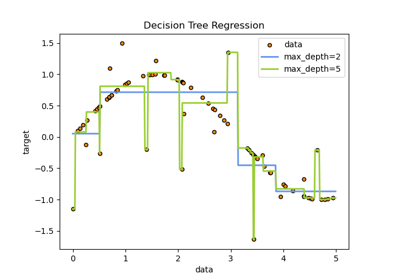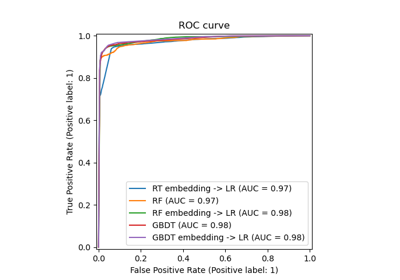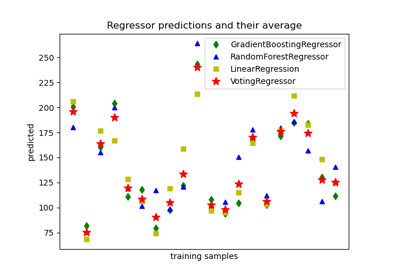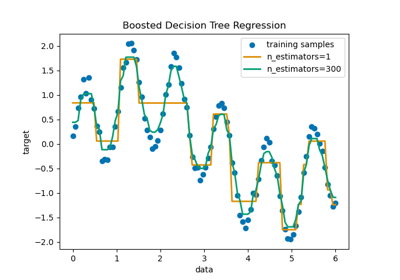注意
转到末尾以下载完整示例代码或通过 JupyterLite 或 Binder 在浏览器中运行此示例。
比较随机森林和多输出元估计器#
一个比较使用随机森林和 multioutput.MultiOutputRegressor 元估计器进行多输出回归的示例。
此示例演示了如何使用 multioutput.MultiOutputRegressor 元估计器执行多输出回归。使用了一个随机森林回归器,它本身支持多输出回归,因此可以比较结果。
随机森林回归器只会预测每个目标的观测值范围内的值或更接近零的值。因此,预测结果偏向于圆心。
使用一个底层特征,模型学习将 x 和 y 坐标作为输出。
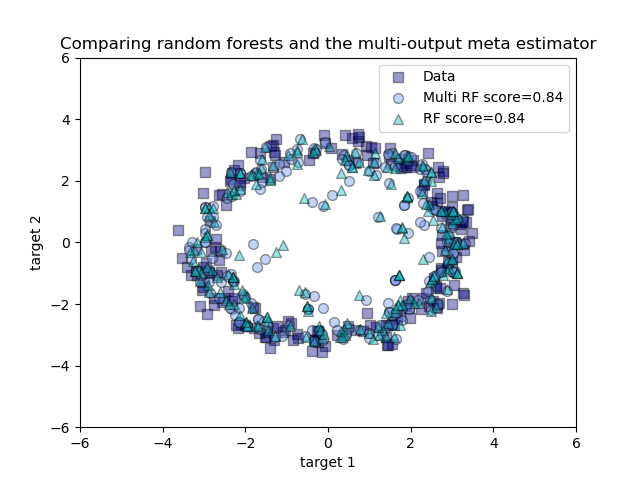
# Authors: The scikit-learn developers
# SPDX-License-Identifier: BSD-3-Clause
import matplotlib.pyplot as plt
import numpy as np
from sklearn.ensemble import RandomForestRegressor
from sklearn.model_selection import train_test_split
from sklearn.multioutput import MultiOutputRegressor
# Create a random dataset
rng = np.random.RandomState(1)
X = np.sort(200 * rng.rand(600, 1) - 100, axis=0)
y = np.array([np.pi * np.sin(X).ravel(), np.pi * np.cos(X).ravel()]).T
y += 0.5 - rng.rand(*y.shape)
X_train, X_test, y_train, y_test = train_test_split(
X, y, train_size=400, test_size=200, random_state=4
)
max_depth = 30
regr_multirf = MultiOutputRegressor(
RandomForestRegressor(n_estimators=100, max_depth=max_depth, random_state=0)
)
regr_multirf.fit(X_train, y_train)
regr_rf = RandomForestRegressor(n_estimators=100, max_depth=max_depth, random_state=2)
regr_rf.fit(X_train, y_train)
# Predict on new data
y_multirf = regr_multirf.predict(X_test)
y_rf = regr_rf.predict(X_test)
# Plot the results
plt.figure()
s = 50
a = 0.4
plt.scatter(
y_test[:, 0],
y_test[:, 1],
edgecolor="k",
c="navy",
s=s,
marker="s",
alpha=a,
label="Data",
)
plt.scatter(
y_multirf[:, 0],
y_multirf[:, 1],
edgecolor="k",
c="cornflowerblue",
s=s,
alpha=a,
label="Multi RF score=%.2f" % regr_multirf.score(X_test, y_test),
)
plt.scatter(
y_rf[:, 0],
y_rf[:, 1],
edgecolor="k",
c="c",
s=s,
marker="^",
alpha=a,
label="RF score=%.2f" % regr_rf.score(X_test, y_test),
)
plt.xlim([-6, 6])
plt.ylim([-6, 6])
plt.xlabel("target 1")
plt.ylabel("target 2")
plt.title("Comparing random forests and the multi-output meta estimator")
plt.legend()
plt.show()
脚本总运行时间: (0 分钟 0.522 秒)
相关示例
